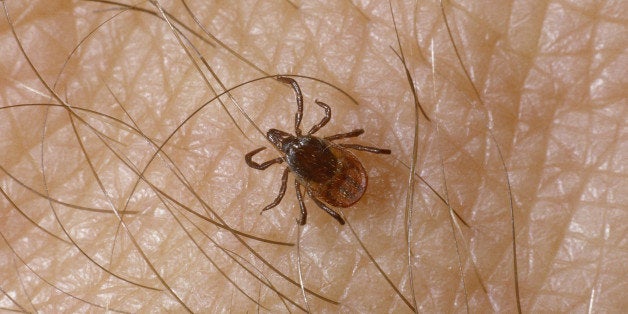
It is time we took a serious look at Lyme disease.
If not treated early and appropriately, infection with Lyme can produce chronic disease that can cause severe pain, debilitating fatigue, reduced quality of life and neurological problems such as impaired memory and concentration.
The CDC now recognizes that more than 300,000 new infections occur every year in the U.S. Most of these infections are acquired in late spring or early summer.
Lyme disease is spreading across the country at an alarming rate. Cases are appearing not only in well-known endemic areas like the northeast, but in California and Florida and in prairie areas of the mid-west.
Most cases of Lyme disease are caused by a bacterium called Borrelia burgdorferi (Bb), which is carried by deer ticks. Different strains of Bb may produce different patterns of illness in individual patients and deer ticks often carry other pathogenic organisms like Anaplasma (a different type of bacteria) or Babesia (a blood-borne parasite).
Each of these organisms can cause a distinct pattern of illness, making Lyme disease one of the most complex, multi-layered infectious diseases ever described.
The symptoms of Lyme disease are so varied it has been called "the great imitator."
Although most people associate deer ticks with deer, they hitch rides on a wide range of small animals including white-footed mice, chipmunks, shrews, prairie dogs, birds, squirrels, raccoons, opossums and skunks, that can bring them right into your backyard. Even birds have been found to carry deer ticks as far north as the Yukon in Canada.
The ticks are so small they may not be seen and many people who develop tick-borne illness have no knowledge of being bitten by a tick.
Textbooks indicate that Lyme disease is easy to treat. Three weeks of an antibiotic like doxycycline and you're cured.
Yet many people treated for Lyme disease have symptoms that persist or appear after antibiotics are finished. A study from Johns Hopkins University found that six months after Lyme treatment, 36 percent of patients reported new-onset fatigue, 20 percent reported widespread pain, and 45 percent had neurocognitive difficulties. These baffling post-treatment symptoms were associated with a significant impairment of life functioning. Post-treatment Lyme symptoms are common and represent a major public health problem.
Great controversy surrounds the causes of these chronic symptoms. In treating patients with Lyme disease and chronic symptoms, I have found several causes, each of which is supported by scientific studies and each of which must be looked for and treated for full recovery to occur. These include:
Co-infection.
The ticks that spread Lyme disease may transmit other bacterial or parasitic infections that require their own specific treatments. Treatment of Bb alone may be insufficient to produce a cure.
Bacterial persistence.
Lyme bacteria have evolved ways to escape the effects of antibiotics and evade the immune system. Special measures may be needed to overcome persisting infection.
Auto-immune damage.
Lyme can trigger the immune system to attack the body's own tissues, even when infection is gone. Restoring immune balance can be critical to recovery. This is especially true when Lyme disease damages the nervous system, but may also occur with Lyme arthritis.
Antibiotic side effects. Treatment of Lyme disease with antibiotics may have unintended consequences. Yeast overgrowth is a well-known effect of antibiotics. A small study from Germany found that almost three-quarters of patients with persisting post-treatment symptoms became symptom-free after treatment with the anti-yeast medication fluconazole.
Strong antibiotics may also damage the energy powerhouses in our bodies' cells, the mitochondria, causing fatigue, muscular weakness or brain disturbances. Nutritional treatments that protect mitochondria or restore mitochondrial function may be needed for a return to health.
Central sensitization, an alteration of brain function producing pain in parts of the body that are not actually damaged. Healing of the brain with medication, nutritional therapies or mind-body therapies may help.
In conclusion, Lyme disease is a major threat to public health and a growing source of chronic illness. For many people, recovery from Lyme disease requires a multifaceted treatment approach that impacts on all aspects of the Lyme problem, individualized to the needs of each person.
To raise awareness of Lyme disease, I will be doing a Free Webinar on Wednesday, June 11 at 7 p.m. EST.
Now I'd like to hear from you:
Do you have unexplained symptoms?
Have your been tested for Lyme disease or other tick-borne diseases?
How do you think you may have gotten Lyme?
Please let me know your thoughts by posting a comment below.
Best Health,
Leo Galland, M.D.
Important: Share the health with your friends and family by forwarding this article to them, and sharing and liking on Facebook.
Leo Galland, M.D. is a board-certified internist, author and internationally recognized leader in integrated medicine. Dr. Galland is the founder of Pill Advised, a web application for learning about medications, supplements and food. Sign up for FREE to discover how your medications and vitamins interact. Watch his videos on YouTube and join the Pill Advised Facebook page.
This information is provided for general educational purposes only and is not intended to constitute (i) medical advice or counseling, (ii) the practice of medicine or the provision of health care diagnosis or treatment, (iii) or the creation of a physician-patient relationship. If you have or suspect that you have a medical problem, contact your doctor promptly.